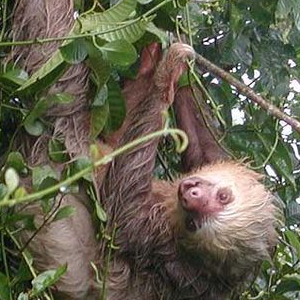 Smart Citations
Smart CitationsSee how this article has been cited at scite.ai
scite shows how a scientific paper has been cited by providing the context of the citation, a classification describing whether it supports, mentions, or contrasts the cited claim, and a label indicating in which section the citation was made.
Post-release ecology of rehabilitated Hoffmann’s two-toed sloths in Panamá
The field of wildlife rescue and rehabilitation continues to grow as human expansion increases the rate of deforestation in Latin America. Sloths (Bradypus spp. and Choloepus spp.) are often admitted to rescue centers throughout Latin America due to their poor dispersal abilities and vulnerability to anthropogenic impacts. Although post-release monitoring is fundamental to measuring the success of wildlife rescue programs, few studies have assessed the outcomes of releasing hand-reared sloths back into the wild. We studied the ecology of rehabilitated and relocated Hoffmann’s two-toed sloths (Choloepus hoffmanni) in central Panamá during 2019- 2020. Eleven two-toed sloths rescued from the wild were hand-reared in captivity for 727±193 days and then radiomarked, placed in an outdoor 500 m2 soft-release enclosure for 3 months, and released in a nearby national park. While in the softrelease enclosure, two-toed sloths spent 80.0% of their time resting and became active and more alert in the evening (p=0.01). Upon release into the wild, two-toed sloths traveled a mean linear distance of 82.3±21.6 m and a mean distance of 25.6±9.5 m between successive radiolocations. The mean home range size was 2.92±1.19 ha, with females occupying larger areas than males. Two-toed sloths used trees with a smaller dbh than available (p≤0.001; p≤0.015) and selected trees with dense crowns and ≥50% lianas. Eight mortalities were recorded, with predation and natural causes being the main causes of mortality. Monthly survival was 0.72±0.14 and did not differ (p≤0.30) between males (1.00±0.00) and females (0.44±0.22). Rehabilitated two-toed sloths exhibited behavioral and space use patterns similar to wild two-toed sloths, with the exception of having lower survival rates following release in the wild. Our study provides information that can be useful in evaluating the efficacy of sloth rescue and rehabilitation programs throughout Latin America.
Supporting Agencies
Pan-American Conservation Association, Cooperative Wildlife Research LaboratoryHow to Cite

This work is licensed under a Creative Commons Attribution-NonCommercial 4.0 International License.
PAGEPress has chosen to apply the Creative Commons Attribution NonCommercial 4.0 International License (CC BY-NC 4.0) to all manuscripts to be published.









